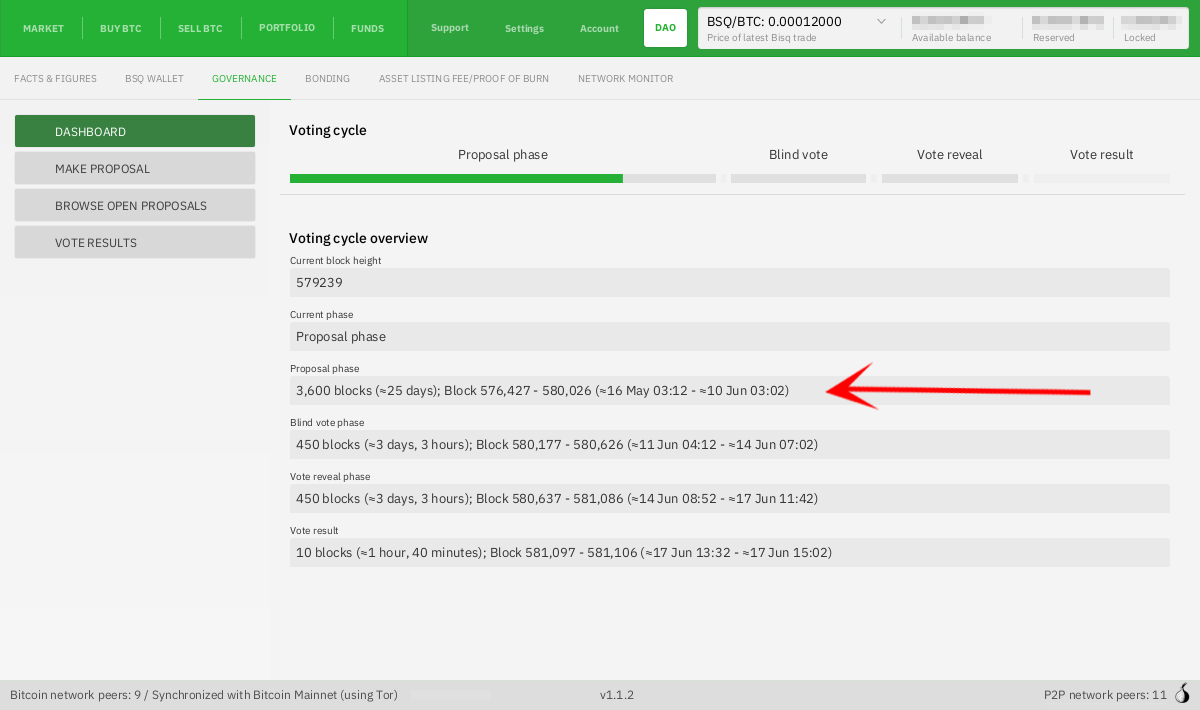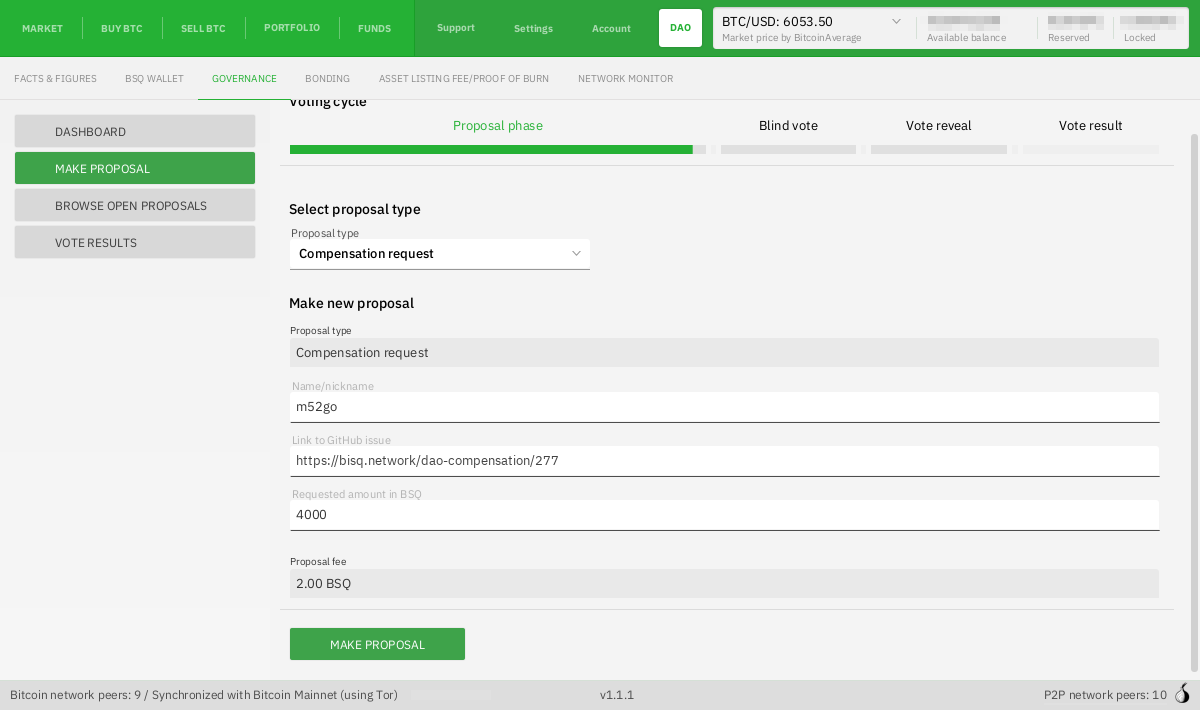Have you contributed to the Bisq Network? Great, and thank you! Here is how to request compensation for your work, and vote on requests from others.
If you’re not sure how to start contributing, check out our Contributor Checklist for tips on getting started and figuring out what to work on.
Background
Compensation requests are generally made for work done in the current DAO cycle—after the end of the last proposal phase, and before the end of the current one—but you can make a request for work done any time in the past.
| Compensation requests can only be made for delivered work. Work that’s planned or in-progress is not eligible for compensation. See more on what that means here. Generally, work merged to the master branch of a repository can be considered delivered (if applicable). |
Each DAO cycle is roughly 1 month long, but timing is based on the Bitcoin block height, so exact dates for the start & end of DAO cycles vary.
Make sure you check the Bisq DAO dashboard to get an idea of the submission deadline for the current cycle:

Block confirmation times can vary quite a bit, so keep an eye on these dates, and don’t wait until the last minute!
You must file a compensation request before the end of the current proposal phase in order to have it evaluated in the current voting cycle. If you miss it, don’t worry—you can submit your request in the next proposal phase.
Submit your compensation request
List your work in a new GitHub issue
Making compensation requests and voting takes place in the Bisq DAO, but data stored there is minimized to decrease the burden on the peer-to-peer network (and on the Bitcoin network).
Hence the GitHub issue. All the details of what work you did and why it’s valuable can get long, so you’ll put those details in a GitHub issue, and then link to that issue in your compensation request on the Bisq DAO.
Create the issue
The issue should go in the bisq-network/compensation repository, and it should be titled in the following format:
For Cycle N
Where N is the number of the current cycle. Please stick to this convention—it’s cleaner and much easier to track when looking back in time.
List your work
Your issue needs to convince Bisq stakeholders what you did, how much it’s worth, and why it’s valuable.
In order to make your case as strong as possible, your request should include the following information:
-
The total amount you are requesting in BSQ
-
Links to issues, pull requests, and other "evidence" for any work you want to be compensated for
-
Comments that help explain what the work is, why it is valuable, etc.
-
Links to role reports, if you hold any roles in the Bisq network
| This is a big reason that it’s critical that everything you do for Bisq be as public, verifiable, and documented as possible, and that everything you do has positive consensus with multiple stakeholders so you know you’re not wasting your time. |
Even then, not all stakeholders will be familiar with your work, so it’s important to be as thorough as you can when making a compensation request so there’s enough context for those unfamiliar with your work to make an informed vote.
Value your work
As mentioned above, Bisq contributions are only eligible for compensation once delivered. For code, that means merged to master, and for non-code contributions that means already delivered. How you determine the value you request is up to you, but it should be based on the value of the contribution you made, not on the raw time you spent.
A good rule of thumb, if you are unsure about the value of your contribution: consider what you would charge for your work if you did it as a freelancer.
For example, it might be reasonable to request 50 BSQ for fixing some typos in a doc. But requesting 1000 BSQ for that same task, just because it took you a few hours to read through the doc, will probably be rejected.
See the current BSQ price, open trades, trade history and other information on the Bisq Markets page.
See this link for an example compensation request.
Wait for team lead review
Per the compensation request review process, your compensation request will be reviewed by the team lead(s) responsible for the work you delivered. You may be asked for further information or to revise your compensation request. For this reason, please do not submit your compensation request to the DAO in the next step until this review process is complete!
File your compensation request in the DAO
When the team lead review process is complete, you’re ready to file your request for DAO voting.
BSQ is issued on Bisq when a compensation request is approved through DAO voting, so your compensation request needs to be filed there in order for you to actually be paid.
Once you’ve documented all details of your request in a new issue on GitHub, make a new compensation request proposal on Bisq:

Make sure you select Compensation request as the proposal type. Also make sure you use a name that stakeholders will recognize (or at least one they can cross-reference with your other online profiles like GitHub, Keybase, forum, etc).
For the proposal link, be sure to use this format: https://bisq.network/dao-compensation/#, where # is the number of your GitHub issue. For example, if your compensation request’s GitHub URL is https://github.com/bisq-network/compensation/issues/33, the URL in your DAO compensation request should be https://bisq.network/dao-compensation/33. Don’t copy the GitHub link directly—it won’t work!
|
Why not just use GitHub links?
Bisq may not use GitHub forever. But the Bitcoin blockchain is forever, and proposal URLs cannot be changed—the Bitcoin transaction corresponding to a Bisq DAO proposal includes a hash of the proposal’s data object, which includes the proposal URL. This is why Bisq proposals require a URL with a domain name that Bisq controls: if proposal data ever needs to be migrated, the links can remain the same. |
When you’re ready, click Make proposal to confirm your proposal for voting in the current cycle. Proposal data cannot be edited, so make sure everything is correct, especially the amount you’re requesting.
If you need to make a change, you can delete the proposal and make a new one while the proposal phase is still active, but you’ll need to pay the proposal fee again. Once the proposal phase is over, proposals cannot be added or removed until the next proposal phase.
| A compensation request is a type of proposal, and proposals cost a fee to make in the Bisq DAO. Currently that fee is 2 BSQ. Since a compensation request is intended to issue new BSQ, you’ll also need to include a small amount of bitcoin to be colored into BSQ if your proposal is accepted—100 satoshis × [requested BSQ amount]. See more details in our User Guide. |
The BSQ and BTC is automatically added to your proposal transaction by Bisq, but the BTC needs to be in your Bisq BTC wallet. Make sure you have enough in there before making your request. Keep in mind that you’ll also need some BSQ and BTC for the other proposal phases (vote & vote reveal).
When you successfully submit your proposal in the DAO, it’ll propagate across the Bisq peer-to-peer network and be ready for stakeholders to vote on in the voting phase. If your request is approved, you will see the BSQ you requested in your wallet after the voting phase is over.
Vote on requests from others
It’s not strictly necessary to vote on others' proposals, but highly encouraged that all stakeholders take part in decision-making for the network.
You can see how to take part in voting and the rest of the DAO cycle here.
Questions
If something doesn’t make sense, don’t hesitate to reach out. There’s a community of people to help you on Keybase, the Bisq forum, and the /r/bisq subreddit.
Learn more
BSQ is a core element of Bisq’s governance mechanism, allowing contributors and users to have a hand in crafting the strategy of the project through a voting process.
You can learn more about the overall mechanism in this doc and these videos.
Our user reference covers more practical details on using the Bisq DAO, and our technical reference covers technical details. Check out this page for all Bisq DAO resources.